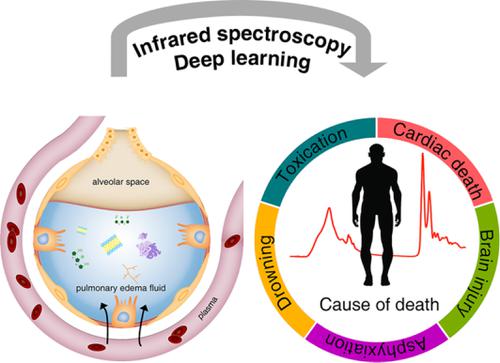当前位置:
X-MOL 学术
›
J. Biophotonics
›
论文详情
Our official English website, www.x-mol.net, welcomes your
feedback! (Note: you will need to create a separate account there.)
Determination of causes of death via spectrochemical analysis of forensic autopsies-based pulmonary edema fluid samples with deep learning algorithm.
Journal of Biophotonics ( IF 2.0 ) Pub Date : 2020-01-27 , DOI: 10.1002/jbio.201960144 Hancheng Lin 1, 2 , Yiwen Luo 1 , Qiran Sun 1 , Kaifei Deng 1 , Yijiu Chen 1 , Zhenyuan Wang 2 , Ping Huang 1
Journal of Biophotonics ( IF 2.0 ) Pub Date : 2020-01-27 , DOI: 10.1002/jbio.201960144 Hancheng Lin 1, 2 , Yiwen Luo 1 , Qiran Sun 1 , Kaifei Deng 1 , Yijiu Chen 1 , Zhenyuan Wang 2 , Ping Huang 1
Affiliation

|
This study investigated whether infrared spectroscopy combined with a deep learning algorithm could be a useful tool for determining causes of death by analyzing pulmonary edema fluid from forensic autopsies. A newly designed convolutional neural network‐based deep learning framework, named DeepIR and eight popular machine learning algorithms, were used to construct classifiers. The prediction performances of these classifiers demonstrated that DeepIR outperformed the machine learning algorithms in establishing classifiers to determine the causes of death. Moreover, DeepIR was generally less dependent on preprocessing procedures than were the machine learning algorithms; it provided the validation accuracy with a narrow range from 0.9661 to 0.9856 and the test accuracy ranging from 0.8774 to 0.9167 on the raw pulmonary edema fluid spectral dataset and the nine preprocessing protocol‐based datasets in our study. In conclusion, this study demonstrates that the deep learning‐equipped Fourier transform infrared spectroscopy technique has the potential to be an effective aid for determining causes of death.
中文翻译:

使用深度学习算法通过法医尸检为基础的肺水肿液体样品的光谱化学分析确定死亡原因。
这项研究调查了红外光谱结合深度学习算法是否可以通过分析法医尸检的肺水肿液来确定死亡原因。一种新设计的基于卷积神经网络的深度学习框架称为DeepIR和八种流行的机器学习算法,用于构造分类器。这些分类器的预测性能表明,在确定死亡原因的分类器中,DeepIR优于机器学习算法。而且,与机器学习算法相比,DeepIR通常较少依赖预处理程序。它提供的验证准确度在0.9661至0.9856的狭窄范围内,而测试准确度则在0.8774至0的范围内。我们研究中的原始肺水肿流体频谱数据集和9个基于预处理协议的数据集上的9167。总之,这项研究表明,配备了深度学习功能的傅立叶变换红外光谱技术可以有效地确定死亡原因。
更新日期:2020-01-27

中文翻译:

使用深度学习算法通过法医尸检为基础的肺水肿液体样品的光谱化学分析确定死亡原因。
这项研究调查了红外光谱结合深度学习算法是否可以通过分析法医尸检的肺水肿液来确定死亡原因。一种新设计的基于卷积神经网络的深度学习框架称为DeepIR和八种流行的机器学习算法,用于构造分类器。这些分类器的预测性能表明,在确定死亡原因的分类器中,DeepIR优于机器学习算法。而且,与机器学习算法相比,DeepIR通常较少依赖预处理程序。它提供的验证准确度在0.9661至0.9856的狭窄范围内,而测试准确度则在0.8774至0的范围内。我们研究中的原始肺水肿流体频谱数据集和9个基于预处理协议的数据集上的9167。总之,这项研究表明,配备了深度学习功能的傅立叶变换红外光谱技术可以有效地确定死亡原因。












































 京公网安备 11010802027423号
京公网安备 11010802027423号